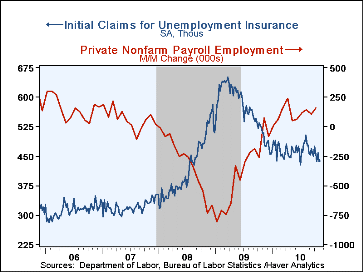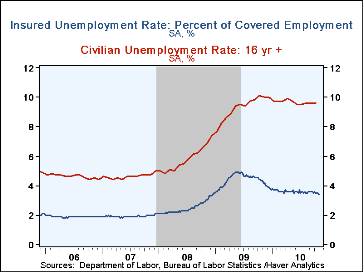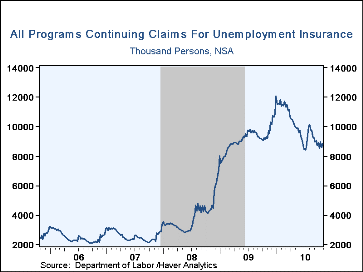 Global| Nov 18 2010
Global| Nov 18 2010U.S. Claims For Jobless Insurance Tick Higher
by:Tom Moeller
|in:Economy in Brief
Summary
Initial claims for unemployment insurance rose slightly last week to 439,000 from 437,000 (revised from 435,000) but remained near their lowest level since early-July. The 4-week moving average, which smoothes out some of the w/w [...]
Initial claims for unemployment insurance rose slightly last week to 439,000 from 437,000 (revised from 435,000) but remained near their lowest level since early-July. The 4-week moving average, which smoothes out some of the w/w volatility, fell to 443,000, the lowest level since September 2008. The latest weekly figure about matched Consensus forecasts for 440,000 claims.
The latest week's claims figure covers the survey period for November nonfarm payrolls with claims falling 16,000 (3.5%) from the October period. During the last ten years there has been a 77% correlation between the level of initial claims and the m/m change in nonfarm payrolls.
Continuing claims for state-administered programs fell 48,000 in the latest week to the lowest level since late-2008. The associated unemployment rate slipped to 3.4%, but the previous week's figure was revised up. These claimants are, however, only about half of the total number of people currently receiving unemployment insurance. Regular extended benefits, with eligibility dependent on conditions in individual states, slipped to 965,710 on October 30, the latest figure available. In July, the Congress renewed the special Emergency Unemployment Compensation program referred to as EUC 2008. By October, it had a sharply reduced 3.967 million beneficiaries. It will now accept claims through November 30 and will be continuing to pay out benefits until April 30, 2011.
The grand total of all claimants for unemployment insurance includes extended and emergency programs as well as railway employees, recently discharged veterans and federal employees. All together, on October 30 the total number of recipients was 8.854 million, off 4.8% y/y and down from the early-January high of 12.066 million. These data are not seasonally adjusted.
Data on weekly unemployment insurance programs are contained in Haver's WEEKLY database and summarized monthly in USECON. Data for individual states, including the unemployment rates that determine individual state eligibility for the extended benefits programs and specific "tiers" of the emergency program, are in REGIONW, a database of weekly data for states and various regional divisions.
| Unemployment Insurance(000s) | 11/13/10 | 11/06/10 | 10/30/10 | Y/Y % | 2009 | 2008 | 2007 |
|---|---|---|---|---|---|---|---|
| Initial Claims | 439 | 437 | 459 | -13.8 | 572 | 419 | 321 |
| Continuing Claims | -- | 4,295 | 4,343 | -23.7 | 5,809 | 3,340 | 2,549 |
| Insured Unemployment Rate(%) | -- | 3.4 | 3.5 | 4.2 (11/09) |
4.4 | 2.5 | 1.9 |
| Total Continuing Claims (NSA) | -- | -- | 8.854M | -4.8% | 9.170M | 3.931M | 2.634M |
Tom Moeller
AuthorMore in Author Profile »Prior to joining Haver Analytics in 2000, Mr. Moeller worked as the Economist at Chancellor Capital Management from 1985 to 1999. There, he developed comprehensive economic forecasts and interpreted economic data for equity and fixed income portfolio managers. Also at Chancellor, Mr. Moeller worked as an equity analyst and was responsible for researching and rating companies in the economically sensitive automobile and housing industries for investment in Chancellor’s equity portfolio. Prior to joining Chancellor, Mr. Moeller was an Economist at Citibank from 1979 to 1984. He also analyzed pricing behavior in the metals industry for the Council on Wage and Price Stability in Washington, D.C. In 1999, Mr. Moeller received the award for most accurate forecast from the Forecasters' Club of New York. From 1990 to 1992 he was President of the New York Association for Business Economists. Mr. Moeller earned an M.B.A. in Finance from Fordham University, where he graduated in 1987. He holds a Bachelor of Arts in Economics from George Washington University.










